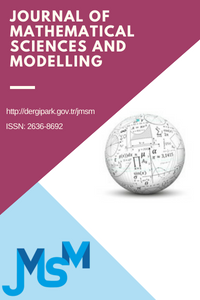Reduced Order Modelling of Shigesada-Kawasaki-Teramoto Cross-Diffusion Systems
Reduced Order Modelling of Shigesada-Kawasaki-Teramoto Cross-Diffusion Systems
discontinuous Galerkin method, discrete empirical interpolation method, proper orthogonal decomposition Shigesada-Kawasaki-Teramoto equation,
___
- [1] H. Murakawa, A linear scheme to approximate nonlinear cross-diffusion systems, Esaim Math. Model. Numer. Anal., 45(6) (2011), 1141-1161.
- [2] N. Shigesada, K. Kawasaki, E. Teramoto, Spatial segregation of interacting species, J. Theor. Biol., 79 (1) (1979), 83-99.
- [3] H. Murakawa, A linear finite volume method for nonlinear cross-diffusion systems, Numer. Math., 136 (1) (2017), 1-26.
- [4] H. Murakawa, A solution of nonlinear diffusion problems by semilinear reaction-diffusion systems, Kybernetika, 45 (4) (2009), 580-590.
- [5] W. J. Barrett, F. J. Blowey, Finite element approximation of a nonlinear cross-diffusion population model, Numer. Math., 98 (2) (2004), 195-221.
- [6] L. Chen, A. J¨ungel, Analysis of a parabolic cross-diffusion population model without self-diffusion, J. Differ. Equ., 224 (1) (2006), 39-59.
- [7] B. Andreianov, M. Bendahmane, R. Ruiz-Baier, Analysis of a finite volume method for a cross-diffusion model in population dynamics, Math. Models Methods Appl. Sci. 21 (02) (2011), 307-344.
- [8] B. Riviere, Galerkin Methods for Solving Elliptic and Parabolic Equations: Theory and Implementation, SIAM, 2008.
- [9] H. Murakawa, Cross-diffusion systems: RDS approximation and numerical analysis, Publications of the Research Institute for Mathematical Sciences, 1924 (2014), 21–29.
- [10] K. Kunisch, S. Volkwein, Galerkin proper orthogonal decomposition methods for parabolic problems, Numer. Math., 90 (1) (2001), 117-148.
- [11] S. Volkwein, Proper orthogonal decomposition: Theory and reducedorder modelling, Lecture Notes, University of Konstanz, 4 (4) (2013), 1-29.
- [12] B. Karasözen, G. Mülayim, M. Uzunca, S. Yılıdz, Reduced order modelling of nonlinear cross-diffusion systems, Appl. Math. Comput., 401 (2021), 126058.
- [13] M. Barrault, Y. Maday, N. C. Nguyen, A. T. Patera, An empirical interpolation method: application to effcient reduced-basis discretization of partial differential equations, Comptes Rendus Math., 339 (9) (2004), 667-672.
- [14] S. Chaturantabut, D. C. Sorensen, Nonlinear model reduction via discrete empirical interpolation, SIAM J. Scı. Comput., 32 (5) (2010), 2737-2764.
- [15] S. Chaturantabut, D. C. Sorensen, A state space error estimate for POD-DEIM nonlinear model reduction, SIAM J. Numer. Anal., 50 (1) (2012), 46-63.
- [16] B. Karasözen, T. Küçükseyhan, M. Uzunca, Structure preserving integration and model order reduction of skew-gradient reaction-diffusion systems, Ann. Oper. Res., 258 (1) (2017), 79-106.
- [17] N. Halko, P. G. Martinsson, J. A. Tropp, Finding structure with randomness: Probabilistic algorithms for constructing approximate matrix decompositions, SIAM Review, 53 (2) (2011), 217-288.
- [18] M. W. Mahoney, Randomized algorithms for matrices and data, Found. Trends Mach. Learn., 3 (2) (2011), 123-224.
- [19] G. Gambino, M. Lombardo, M. Sammartino, Pattern formation driven by cross-diffusion in a 2D domain, Nonlinear Anal. Real World Appl., 14 (3) (2013), 1755-1779.
- ISSN: 2636-8692
- Yayın Aralığı: Yılda 3 Sayı
- Başlangıç: 2018
- Yayıncı: Mahmut AKYİĞİT
Application of Fractional $SPR$ Psychological Disease Model in Turkey and Stability Analysis
Zafer ÖZTÜRK, Halis BİLGİL, Sezer SORGUN
Quantitative Aeroelastic Stability Prediction of Wings Exhibiting Nonlinear Restoring Forces
Qualitative Study of a Discrete-Time Harvested Fishery Model in the Presence of Toxicity
Reduced Order Modelling of Shigesada-Kawasaki-Teramoto Cross-Diffusion Systems
